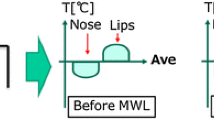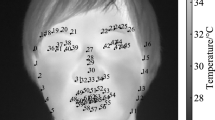Abstract
Individuals exhibit two types of responses when exposed to external stimuli. These are called stress-coping responses, or active and passive coping responses, respectively. These stress-coping responses are discriminated by differences in the fluctuations of hemodynamic parameters, such as cardiac output (CO), total peripheral resistance (TPR), and mean blood pressure (MBP), and others. However, the existing method for measuring hemodynamic parameters is contact measurement, which involves wearing a continuous blood pressure cuff; thus, a remote measurement method is required. Therefore, we focused on facial thermal imaging, remotely measurable indicator of the cardiovascular system. We constructed a model to estimate stress-coping responses from the spatial characteristics of facial thermal images using a CNN and sparse coding. However, the standard spatial distribution of facial thermal images of stress-coping response states has not yet been examined. Therefore, in this study, we analyzed the standard spatial distribution of facial thermal images of stress-coping response states. To elicit each stress-coping response, a cold pressure task and a game task were performed. Facial thermal images and hemodynamic parameters were recorded during the experiments. The measured hemodynamic parameters confirmed the elicitation of a stress-coping response. Additionally, using the measured facial thermal images, we evaluated the deviation of the stress-coping response states from a person’s normal state and the standard spatial distribution of each stress-coping response. The results showed that the stress-coping response states deviated from a person’s normal state. In addition, the standard spatial distribution differed for each stress-coping response.











Similar content being viewed by others
Data availability
The data that support the findings of this study are available on request from the corresponding author. The data are not publicly available due to restrictions e.g. their containing information that could compromise the privacy of research participants.
References
Sawada S (1998) New physiological psychology (under the supervision of Y. Miyata), Chapter 10. Kitaoji Books, Kyoto, pp 172–195
Sherwood Andrew, Dolan Carol A, Light Kathleen C (1990) Hemodynamics of blood pressure responses during active and passive coping. Psychophysiology 27(6):656–668
Bando S, Asano H, Nozawa A (2015) Analysis of physiological effect of reading books by paper and electronic medium. IEEJ Trans Electron Inf Syst 135(5):520–52
Watanuki T, Nozawa A (2014) Estimation of preference for TV video content and viewing style by independence nervous system index. IEEJ Trans Electron Inf Syst 134(10):1551–1556 ((In Japanese))
Garbey M, Sun N, Merla A, Pavlidis I (2007) Contact-free measurement of cardiac pulse based on the analysis of thermal imagery. IEEE Trans Biomed Eng 54(8):1418–1426. https://doi.org/10.1109/TBME.2007.891930
Chekmenev SY, Rara H, Farag AA (2006) Non-contact, wavelet-based measurement of Vital signs using thermal imaging. ICGST Int J Graph Vis Image Process 6:25–30
Gault TR, Farag AA (2013) A fully automatic method to extract the heart rate from thermal video. In: 2013 IEEE conference on computer vision and pattern recognition workshops (CVPRW), pp 336–341
Ioannou Stephanos, Gallese Vittorio, Merla Arcangelo (2014) Thermal infrared imaging in psychophysiology: potentialities and limits. Psychophysiology 51(10):951–963
Clay-Warner Jody, Robinson Dawn T (2015) Infrared thermography as a measure of emotion response. Emot Rev 7(2):157–162
Salazar-López E, Domínguez E, Ramos VJ, de la Fuente J, Meins A, Iborra O, Gálvez G, Rodríguez-Artacho MA, Gómez-Milán E (2015) The mental and subjective skin: emotion, empathy, feelings and thermography. Conscious Cognit 34:149–162
Zenju H, Nozawa A, Tanaka H, Ide H (2004) Estimation of unpleasant and pleasant states by nasal thermogram. IEEJ Trans Electron Inf Syst 124(1):213–214
Kent Nagumo, Kosuke Oiwa, Akio Nozawa (2021) Spatial normalization of facial thermal images using facial landmarks. Artif Life Robot 26(4):481–487
Author information
Authors and Affiliations
Corresponding author
Additional information
Publisher's Note
Springer Nature remains neutral with regard to jurisdictional claims in published maps and institutional affiliations.
This work was presented in part at the joint symposium of the 28th International Symposium on Artificial Life and Robotics, the 8th International Symposium on BioComplexity, and the 6th International Symposium on Swarm Behavior and Bio-Inspired Robotics (Beppu, Oita and Online, January 25-27, 2023).
About this article
Cite this article
Oyama, S., Oiwa, K. & Nozawa, A. Analysis of spatial distribution characteristics of facial skin temperature on stress coping. Artif Life Robotics (2024). https://doi.org/10.1007/s10015-024-00942-x
Received:
Accepted:
Published:
DOI: https://doi.org/10.1007/s10015-024-00942-x




